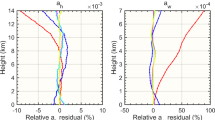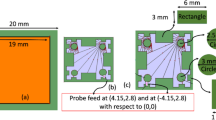Abstract
Satellite communication networks play an important role in the “digital divide” problem, by offering broadband services everywhere in the world. The ever increasing demand for multimedia services has led to the use of Ku, Ka and V band in modern satellite communication networks. In these frequency bands, rain attenuation is the most dominant propagation fading mechanism. Moreover, interference due to propagation phenomena deteriorates the performance of the satellite links and should be taken into account for the reliable design of satellite communication networks. In this paper, an analytical physical mathematical propagation model is presented for the prediction of channel capacity statistics of a dual-polarized interfered broadband satellite link. Rain attenuation spatial inhomogeneity is incorporated in the analysis with the employment of correlated slant paths. The obtained numerical results show the significance of these effects to channel capacity estimation. Finally, the proposed model may be used towards the optimum utilization of the satellite channel capacity by means of adaptive fade mitigation schemes.








Similar content being viewed by others
References
R. K. Crane, “Propagation Handbook for Wireless Communication System Design” (CRC Press LLC, 2003).
ITU-R Recommendation S.741–2, “Carrier-to-interference calculations between networks in the fixed- satellite service”, 1994.
ITU-R Recommendation S.1323–2, “Maximum permissible levels of interference in a satellite network (GSO/FSS; non-GSO/FSS; non-GSO/MSS feeder links) in the fixed-satellite service caused by other codirectional FSS networks below 30 GHz”, 2002.
J. D. Kanellopoulos, A. D. Panagopoulos, and S. N. Livieratos, “A comparison of copolar and cochannel satellite interference prediction models with experimental results at 11.6 and 20 GHz”, Int. Jour. Sat. Commun. 18, 107–120 (2000).
ITU-R Recommendation P.837–4, “Characteristics of precipitation for propagation modeling”, 2003.
ITU-R Recommendation P.839–3, “Rain height model for prediction methods”, 2003.
J. D. Kanellopoulos and A. D. Panagopoulos, “Ice Crystals and Raindrop Canting Angle affecting the Performance of a Satellite System suffering from Differential Rain Attenuation and Cross-Polarization”, Radio Science 36(5), 927–940, (2001).
ITU-R Recommendation P.838–2, “Specific attenuation model for rain for use in prediction methods”, 2003.
A. D. Panagopoulos, P.-D. M. Arapoglou, and P. G. Cottis, “Satellite Communications at Ku, Ka, and V Bands: Propagation Impairments and Mitigation Techniques”, IEEE Communications Surveys and Tutorials 6(3), Third Quarter (2004).
M. Filip and E. Vilar, “Optimum Utilization of the Channel Capacity of a Satellite Link in the presence of Amplitude Scintillations and Rain Attenuation”, IEEE Transactions on Communications 38(11), November (1990).
M. Filip and E. Vilar, “Adaptive modulation as a fade countermeasure. An Olympus experiment”, Int. Jour. Sat. Commun. 8, 31–41 (1990).
Acknowledgement
This work is co-funded by the European Social Fund (75%) and National Resources (25%), Operational Program for Educational and Vocational Training II (EPEAEK II) and particularly the Program Archimedes II in ASPETE.
Author information
Authors and Affiliations
Corresponding author
Rights and permissions
About this article
Cite this article
Panagopoulos, A.D., Chatzarakis, G.E. Channel Capacity Statistics of an Interfered Broadband Satellite Link. Int J Infrared Milli Waves 28, 169–179 (2007). https://doi.org/10.1007/s10762-007-9193-0
Received:
Accepted:
Published:
Issue Date:
DOI: https://doi.org/10.1007/s10762-007-9193-0




